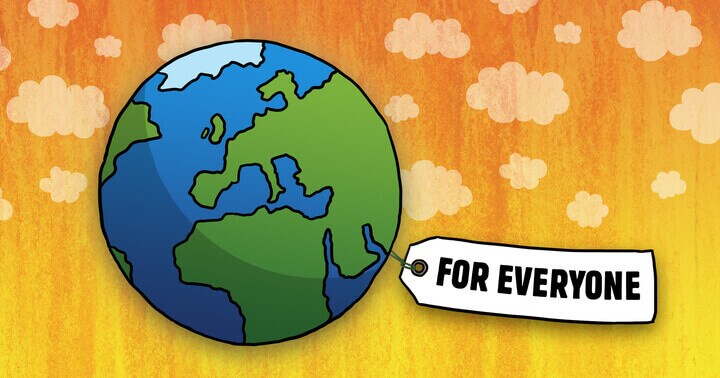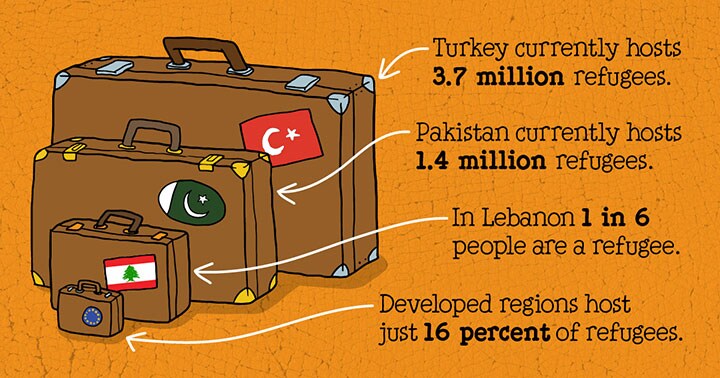
A little more than 40 years ago, Ben Cohen and Jerry Greenfield started scooping ice cream out of a groovy little renovated petrol station in Burlington, Vermont. We’ve come a long way since then, but one thing that hasn’t wavered is our commitment to supporting marginalised people and communities around the globe. And right now, there’s a group of people who need this kind of help more than ever.
The adults and children we’re talking about have left home not because they want to, but because they have to. They’re driven by fear of persecution, conflict, violence, or human-rights violations. To stay in their cities and towns means putting their families in danger, and they’ve decided to gamble on the unknown rather than to do that. And as people with families and homes ourselves, we empathise, and we want to help.
Nearly 70.8 million people need our help rebuilding their lives.
According to research published on June 20 by the United Nations High Commissioner for Refugees (UNHCR), 70.8 million people have been forcibly displaced worldwide. That’s 2 million more people than last year, and the highest number recorded in UNHCR history—ever.
Over the past five years, many displaced people have already started to rebuild their lives in the safety of Europe. Maybe you’ve been lucky enough to meet some of them—perhaps already working as the doctors, lawyers, farmers, engineers, scientists or teachers they were in their home countries. Or maybe you’ve met people who are still seeking to attain the livelihoods they left behind. Or maybe the people you’ve met are still on the move.
And maybe you haven’t met any newcomers yet, and that’s prompted you to wonder where, exactly, all of the people desperately seeking a new life have landed. Not everyone ends up in the same place. But here’s a little cheat sheet to use so you know when and where to extend a word of welcome to someone who has had to leave their home country for somewhere new.
First, here’s a bit more about refugees.
Before diving into the statistics about where refugees end up around the world, it’s important to get your vocabulary right. Those 70 million forcibly displaced people are split into three main groups—asylum-seekers, refugees, and internally displaced people. (You can read more about that here.) Internally displaced people stay within their own country, but people seeking asylum—those whose requests for sanctuary are still pending—and refugees, who are officially protected as spelled out in the 1951 Refugee Convention, cross international borders to escape violence, persecution or human-rights violations in their home countries. But where, exactly, did they call home first?
Here’s where the vast majority of refugees come from.
Fifty-seven percent of UNHCR refugees come from just three countries: Syria (6.7 million), Afghanistan (2.7 million), and South Sudan (2.3 million). Myanmar and Somalia round out the top five, with 1.1 million and 500,000 people respectively. Venezuela also made news, as it reported the greatest number of new asylum applications in 2018, with 341,800 people requesting asylum, and with many more asylum claims projected to follow. Most Venezuelan refugees end up in neighbouring Colombia and Peru. That’s a typical pattern in the rest of the world, too.

Here’s where the vast majority of refugees end up.
About 80 percent of refugees now live in neighbouring countries to the ones they formerly called home. As such, for the past five years Turkey has had the world’s largest refugee population, hosting 3.7 million people. Pakistan hosts 1.4 million, followed by Uganda (1.2 million), Sudan (1.1 million) and Germany, at 1.1 million. Geographically, those numbers makes sense, as many refugees travel only as far as is necessary to escape the immediate fear of violence or persecution in their home countries. But economically, those numbers don’t add up at all.
Where should people seeking safety end up?
According to UNHCR, countries in developed regions host just 16 percent of refugees, while one-third of refugees—that’s 6.7 million people—are hosted by the world’s poorest countries. (Also of note: Lebanon and Jordan host the highest number of refugees relative to their population size.)

Helping millions of forcibly displaced people rebuild their lives isn’t easy. But the numbers make it clear that lower- and middle-income countries are hosting more than double the number of refugees compared to their wealthier neighbours. To our way of thinking, that’s not a sustainable division of resources. And the research released by UNHCR on June 20 makes it clear that helping forcibly displaced people is—and will continue to be—an area where the international community needs to join forces to do the greatest good.
We don’t have all the answers. But we entreat you to do your part by extending a warm welcome to anyone who has been forcibly displaced and is trying to make a new home somewhere else. And if you’re in a position to help, step forward! Only through international cooperation can we seek to help people create a safe, valued, and happy new life.
Sweeten Up Your Inbox!
Subscribe now and we'll make sure you get the inside scoop on Ben & Jerry's fun and flavours! It's like dessert for your inbox, and you're going to want seconds.

